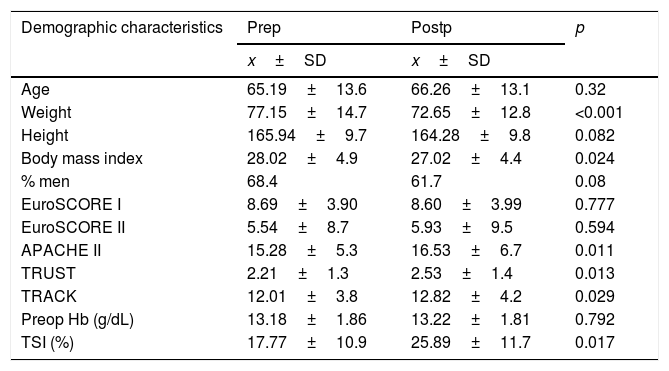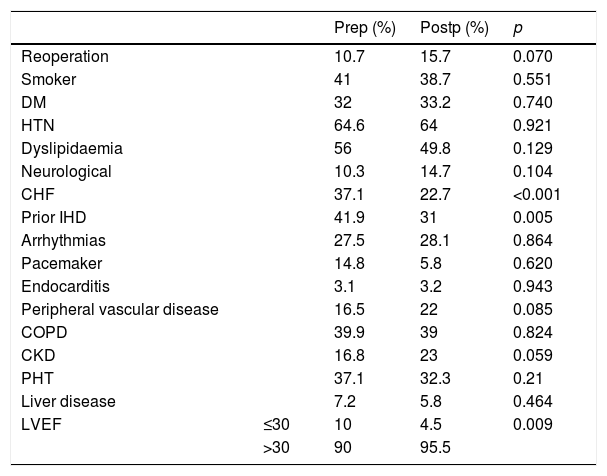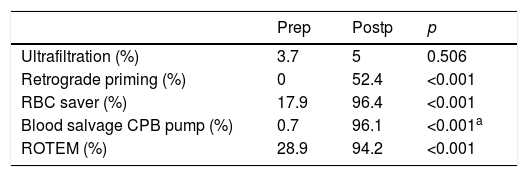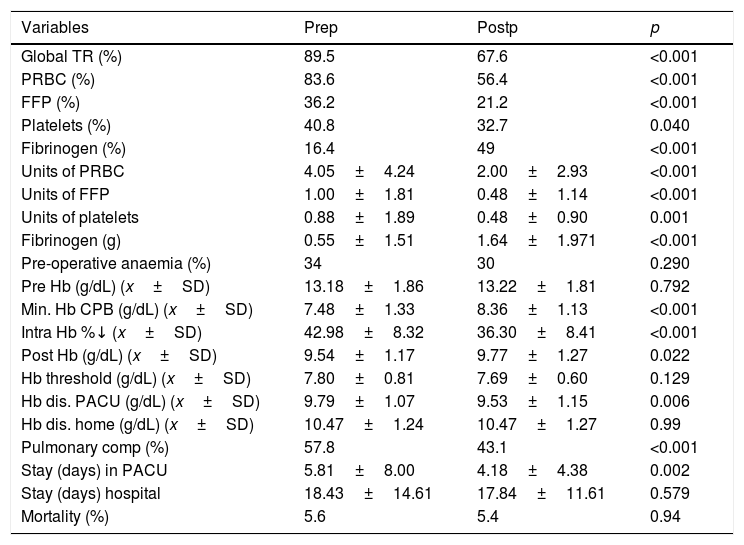The main objective of the study was to evaluate the effect of implementing a blood-saving programme in patients undergoing elective cardiac surgery with an analysis of the transfusion rate and complications.
Materials and methodsA single-centre, observational, retrospective, comparative study which included 604 consecutive patients older than 15 years old undergoing elective cardiac surgery. Two groups of patients were created according to whether or not they were included in a blood-saving protocol, and analysed between December 2012 and July 2013 (293 patients, prep group) and April 2015 to May 2016 (311 patients, posp group).
ResultsThe overall blood product transfusion rate was reduced in the posp group (89.5 vs. 67.6%; p<0.001), as well as individually: red blood cell concentrates (83.6%; p<0.001), fresh frozen plasma (36.2 vs. 21.2%; p<0.001), platelets (40.8 vs. 32.7; p<0.001). By contrast, fibrinogen use increased from 16.4 to 49% (p<0.001). Postoperative complications were similar in both groups, except for pulmonary complications (57.8 vs. 43.1%; p<0.001). Length of hospital stay was similar in both groups except in the Critical Care Unit with longer stay for the prep group (5.81±8.00 vs. 4.18±4.38; p=0.002). Mortality did not change.
ConclusionsThe implementation of a blood-saving programme in the cardiac surgery area has favourable consequences, such as a saving in blood product and a reduction of pulmonary complications, although without decreasing the mortality rate.
El objetivo principal del estudio fue valorar la repercusión de la implantación de un programa de ahorro de sangre en pacientes intervenidos mediante cirugía cardiaca programada con el análisis de la tasa transfusional y las complicaciones.
Materiales y métodosEstudio unicéntrico, observacional, retrospectivo, comparativo que incluyó a 604 pacientes mayores de 15 años consecutivos intervenidos mediante cirugía cardiaca programada. Se analizaron 2grupos de pacientes establecidos por la aplicación o no de un programa de ahorro de sangre entre diciembre de 2012 y julio de 2013 (293 pacientes, grupo prep) y entre abril de 2015 y mayo de 2016 (311 pacientes, grupo posp).
ResultadosDisminuyó la tasa transfusional global de componentes sanguíneos en el grupo posp (89,5 vs. 67,6%; p<0,001) y de manera individual: concentrados de hematíes (83,6 vs. 56,4%; p <0,001), plasma fresco congelado (36,2 vs. 21,2%; p <0,001), plaquetas (40,8 vs. 32,7%; p <0,001); por el contrario, aumentó el uso de fibrinógeno (16,4 vs. 49%; p <0,001). Las complicaciones postoperatorias fueron similares en ambos grupos, salvo las pulmonares, que disminuyeron (57,8 vs. 43,1%; p <0,001). La estancia hospitalaria fue similar en ambos grupos, excepto en la Unidad de Reanimación, con más días en el grupo prep (5,81±8,00 vs. 4,18±4,38; p=0,002). La mortalidad no presentó cambios.
ConclusionesLa implantación de los programas de ahorro de sangre en el Área de Cirugía Cardiaca tiene consecuencias favorables como el ahorro de componentes sanguíneos y la disminución de complicaciones pulmonares, aunque sin consecuencias en la disminución de la mortalidad.












